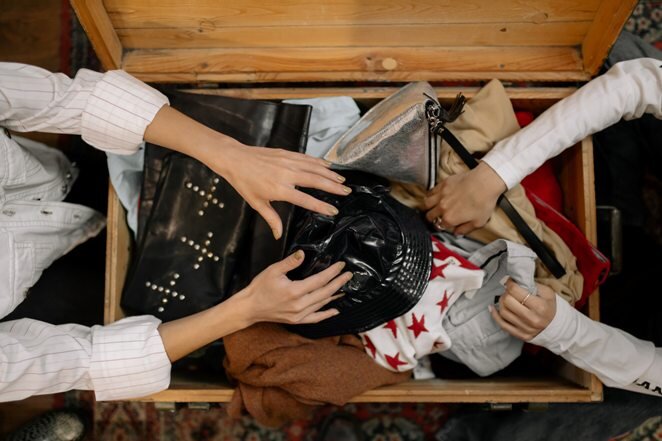Second Hand September
Cotton Bro
We’re big on sustainable second hand shopping here at Peep, not only because you can find unique pieces from different decades, but because it greatly reduces our impact on the planet.
The textile industry alone accounts for about 10% of global greenhouse gas emissions and is a big contributor to the climate emergency. But we can take action by taking part in Oxfam’s Second Hand September Challange to buy nothing new and shop only second hand for the month of September… and beyond.
what is second hand september?
Oxfam
Fast fashion is damaging our planet. The excess waste from this throwaway lifestyle is putting pressure on the environment. People living in the poorest countries are suffering the most yet have done the least to cause it. Shopping and donating with Oxfam helps to raise vital funds to help families tackle the crisis in their communities.
Although Oxfam don’t believe the responsibility to fix the problem lies with us shoppers (agreed) – Second Hand September and slow living is a way of individually doing our bit to make our lives more sustainable.
Check out Oxfam’s pop up shop in London Selfridges full of incredible second hand pieces selected by their thrift expert Bay Garnett. When you donate clothes to Oxfam nothing goes to landfill and now you can donate them by post. Order your free donation bag from Oxfam or donate in-store.
Search #SecondHandSeptember on Instagram to find loads of inspiration and tag @OxfamGB
why shop second hand
Cotton Bro
It’s sustainable
You’re extending the life of clothes, because when you buy a used item you are saving all the resources it took to make that item. It takes 2,700 litres of water to make one new cotton t-shirt compared to a second hand tee from a charity shop which uses none. The same applies for eyewear and homewares - it’s a step towards a circular economy where everything is reused, repaired, and recycled.
More choice, unique pieces
There are so many great wardrobe staples you can find alongside unique gems you can uncover from different eras, from 90s power suits to 70s coats, the trend cycle means that the previous decades are regularly back in fashion. You can find designer items at an affordable price and styles that are no longer being produced. We love that you can express your individuality more with preloved fashion and homewares, find your own style and what truly suits, instead of being dictated by trends.
Keeping clothes out of landfill
13 million items of used clothing ends up in UK landfill every week. When you shop secondhand fashion or homeware, you’re keeping these items out of landfill and back in circulation while reducing the demand for fast fashion and fast homeware.
Secondhand goods are better quality
Vintage items were made to last. Older items are often better made, sometimes handmade from better materials, from a time when quality was prized over quantity. That’s why the vintage market is thriving with so many amazing sellers curating beautful pieces from the 60s, 70s and 80s all in exquisite condition.
If you buy something second hand but decide you no longer want it you can sell it on or donate and keep the cycle going.
Giving back
Shopping and donating with Oxfam, and other charities, helps to raise money for people who are suffering the effects of the climate emergency right now. You could help fund a solar-powered pump that brings water up from underground during dry season, or provide farmers with drought-resistant seeds. When you shop second hand you’re giving back to a charity or small sustainable business instead helping of big boys get bigger.
How to shop second hand
Shopping second hand has never been easier with shops like eBay, Vinted, and DePop you can buy secondhand from the comfort of your sofa. Instagram is a mecca for beautifully curated vintage and preloved fashion and homewares, where sellers do the hard work for you handpicking quality and stand out pieces.
Or if you want to get hands on, there are still charity shops on the high street and their doors are open, if you can’t try items on in a changing room, you can often exchange and return. There’s also the pleasure of thrifting through local fleamarkets, antique shows and car boot sales - it’s addictive.
Here’s our tip tips to shopping second hand..
Know what’s in your wardrobe - knowing what you’ve already got to work with, any pieces that you purchase will save you from repeats.
Go with a shopping list - pieces that you’re missing from your wardorbe that you actually need, will save you from indulging in retail therapy. Charity shops are great for staples like mens tailoring and knitwear.
Know yourself - what styles and shapes suit, colour palettes that work for you and fit in with what’s in your wardrobe.
Know your measurements - vintage clothing comes up smaller than modern sizing so take your measurements before shopping, such as bust, waist and hips.
Give it a good once over - if it’s virtual read the condition report and check the pieces for stains and damage. You can always ask for more information. Old fashioned labels and zips will give you a clue to the pieces age.
Look at what it’s made of - try to source mostly natural fibers like cotton, silk, linen, and wool as they’re more breathable and planet friendly to wash and stay away from anything that needs dry cleaning.
When you shop second hand or vintage, buy only what you need or love, that way you’ll always be shopping sustainably.
Take a peep at our range preloved and vintage second hand frames.
Jo





